By Jeanne Neath
What distresses you most about how the transgender movement is hurting women, girls and Lesbians? For many of us, it is the loss of our women-only or Lesbian-only spaces – from our festivals, to feminist organizing meetings, to Lesbian lands, to goddess circles and more.
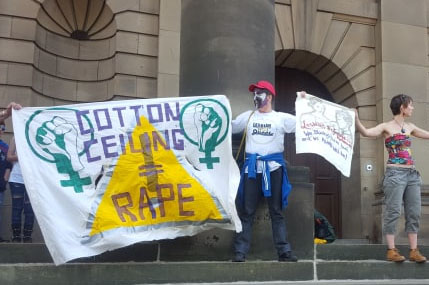
M2T persons not only think they can become women, but also that they should be accepted as Lesbians. When Lesbians refuse to consider them as sexual partners, they accuse us of creating a “cotton ceiling” that shuts them out. The poster is saying that these demands for Lesbians to have sex with males is a form of rape. The photo is from a ReSisters United radical feminist protest at Lancaster Pride in the UK.
We may feel enraged that male-bodied transgender people are allowed to compete in women’s sports and take trophies that rightly belong to women. Knowing that M2T (male to transgender) people are pushing their way into girls’ locker rooms and women’s domestic violence shelters may worry us terribly. Personally, it makes me crazy that Lesbians are being shamed and accused of discrimination in the queer/trans world for not being willing to have sexual or intimate relations with M2T people. Lesbians are supposed to want to have sex with males just because they become transgender, even males with a penis?
Now, ask yourself, what do all these assaults on women, girls and Lesbians have in common? Every single one of these losses for women (and there are many more) is the result of the transactivists’ claim that males can become women and the widespread acceptance of that claim. If it were recognized that males can never become women, M2T people would have no claim on women’s identities or women’s spaces. There would be no basis for them to demand entry into women-only spaces, to compete in women’s sports, to invade girls’ locker rooms, to complain that Lesbians don’t want to have sex with them, and so on. Please take a look below at the informational chart that XX Amazons has developed. You can easily see the central role that the M2T claim that “transwomen are women” plays in harming women on The (Trans) Gender Problem chart displayed below. (Or see a large, easy to read copy of the chart.)
The claim that “transwomen are women” is a preposterous claim. How have transactivists managed to make this strange idea believable to so many people? You can probably guess where I am going with this and, yes, “transideology” and its concept of “gender identity” is the answer.
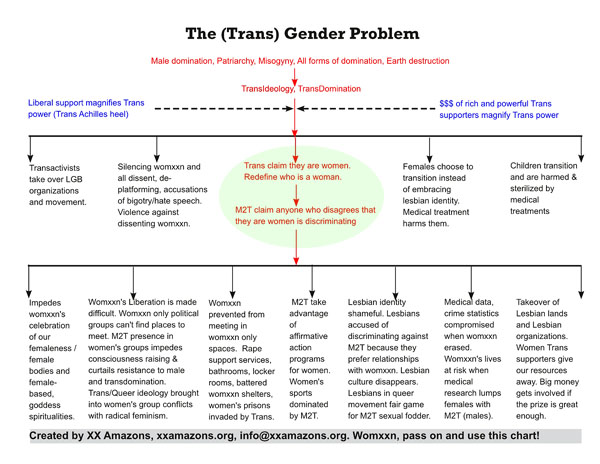
Click on the chart above to see the (Trans) Gender Problem chart in an easy to read size. The M2T claim to be women shown in the green circle at the center of the chart creates all the many harms to women displayed on the bottom row of the chart. “Gender identity” ideology provides the rationale for the M2T redefinition of who is a woman.
The Fabrication and Selling of Gender Identity
Gender identity is defined by the American Psychological Association (APA) as “a person’s deeply-felt, inherent sense of being a boy, a man, or male; a girl, a woman, or female, or an alternative gender…” (listed under their Guidelines for Psychological Practice with Transgender and Gender Nonconforming People). Transgender people (not intersex people) are male or female, as determined by their biological sex. Their only claim to being the “other gender” is that they feel like they are that “gender” and that they present with the “appearance, mannerisms, or other gender related characteristics” prescribed for the other sex (i.e. they conform to sex stereotypes, just the supposedly wrong ones for their sex). Take away the concept of gender identity and M2T people no longer have any basis for their claim to be women.
Origins of “Gender Identity”
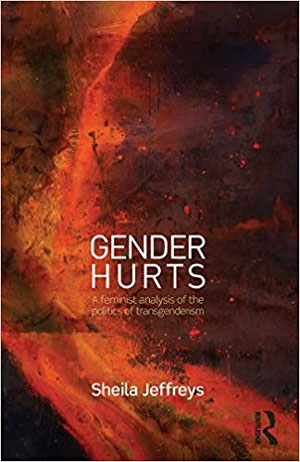 Sheila Jeffreys traced the origins of the concept of “gender identity” in her book, Gender Hurts. In the 1950s and 1960s the medical profession became increasingly engaged with males who wanted to take advantage of advancing medical technologies in endrocrinology and surgery to become transsexual. At that time, the medical profession could not agree on what kinds of treatments were ethical. Some medical professionals strongly believed that treatment should be limited to psychological methods. The sexologists who offered physical treatment hit upon the use of the word “gender” to justify the harms they were inflicting on healthy bodies. Jeffreys quotes Bernice Hausman, who explained in her book, Changing Sex, Transsexuality, Technology and the Idea of Gender, that this justification required “construction of a rhetorical system that posits a prior gendered self.” (p. 27, Gender Hurts) Hausman described gender as “the idea of an identity prior to and within the body that theoretically should dictate the appearance of the subject.” (p. 27, Gender Hurts) (Note: the word “gender” was being used then, but today, “gender identity” would be used.)
Sheila Jeffreys traced the origins of the concept of “gender identity” in her book, Gender Hurts. In the 1950s and 1960s the medical profession became increasingly engaged with males who wanted to take advantage of advancing medical technologies in endrocrinology and surgery to become transsexual. At that time, the medical profession could not agree on what kinds of treatments were ethical. Some medical professionals strongly believed that treatment should be limited to psychological methods. The sexologists who offered physical treatment hit upon the use of the word “gender” to justify the harms they were inflicting on healthy bodies. Jeffreys quotes Bernice Hausman, who explained in her book, Changing Sex, Transsexuality, Technology and the Idea of Gender, that this justification required “construction of a rhetorical system that posits a prior gendered self.” (p. 27, Gender Hurts) Hausman described gender as “the idea of an identity prior to and within the body that theoretically should dictate the appearance of the subject.” (p. 27, Gender Hurts) (Note: the word “gender” was being used then, but today, “gender identity” would be used.)
The sexologists who offered physical treatment hit upon the use of the word “gender” to justify the harms they were inflicting on healthy bodies.
Jeffreys emphasized the impact that transsexuals had on the medical profession with their demands for medical services. These “demanders” were quick to see the usefulness of the idea of an innate “gender” as a justification for their desire to become transsexual. At the time, cross-dressers and transsexuals were easily seen as sexually motivated, having a “paraphilia.” Jeffreys explains:
“The association with sexuality created problems for their access to treatment, and to the seriousness with which they were regarded in the public world. The idea of a ‘gender’ mistake, in which they mysteriously incorporated a ‘feminine essence’, washed them clean of sleaze and enabled them to constitute themselves as a confident rights-bearing minority who were just born different.” (p. 28, Gender Hurts)
According to Jeffreys, the change in language from “transsexual” to “transgender” was likewise motivated by the wish to avoid association with sex and sexual motivation. (p. 28, Gender Hurts)
Is Gender Identity a Ruse?
We have come a long distance from the sexologists of the 1950s and 1960s, but the idea of an innate gender identity has become the centerpiece of transgender ideology. The “born that way” explanation has served to garner public sympathy for both the gay and transgender movements for decades now. Today’s transactivists are well aware of the effectiveness of their essentialist argument, and use it, even though some do not believe it is true. Listen to Emi Koyama, a M2T person who identifies as a so-called “transfeminist”:
“As trans people begin to organize politically, it is tempting to adopt the essentialist notion of gender identity. The cliché popularized by the mass media is that trans people are “women trapped in men’s bodies or vice versa. The attractiveness of such a strategy is clear, as the general population is more likely to become supportive of us if we can convince them that we are somehow born with a biological error over which we have no control. It is also often in tune with our own sense of who we are, which feels very deep and fundamental to us.” (The Transfeminist Manifesto, Emi Koyama)
Koyama and, no doubt, many other transgender people understand that transgender people are not “born that way”, but instead are “made that way” by social forces and by their own choices. Here’s Koyama again:
“Transfeminism believes that we construct our own gender identities based on what feels genuine, comfortable, and sincere to us as we live and relate to others within given social and cultural constaints.” (The Transfeminist Manifesto, Emi Koyama)
Where would the transgender movement be today if the public understood that transgender people are not victims of a “biological error”?
Born or Made?
 The “born that way” ideology still provides many medical practitioners and researchers with a meal ticket. The work of these professionals props up gender identity ideology. Consider Milton Diamond’s study of transgender identical and fraternal twins published in the International Journal of Transgenderism in 2013. In Diamond’s study of 110 transgender twins (74 identical and 36 fraternal twins), 33% of the male identical twins had a transgender twin. The percentage was smaller for female identical twins; just 23% had a transgender twin. These data are damning for the “born that way” argument. Since identical twins have identical genetic makeup, all of the transgender identical twins should have had a trans twin, if the “born that way” argument were true.
The “born that way” ideology still provides many medical practitioners and researchers with a meal ticket. The work of these professionals props up gender identity ideology. Consider Milton Diamond’s study of transgender identical and fraternal twins published in the International Journal of Transgenderism in 2013. In Diamond’s study of 110 transgender twins (74 identical and 36 fraternal twins), 33% of the male identical twins had a transgender twin. The percentage was smaller for female identical twins; just 23% had a transgender twin. These data are damning for the “born that way” argument. Since identical twins have identical genetic makeup, all of the transgender identical twins should have had a trans twin, if the “born that way” argument were true.
Diamond did find a very low rate of “concordance” for the fraternal twins in his study (one out of 21 for male twins and zero out of 15 for female twins were both transgender). Expected discrepancies in the genetic makeup of the fraternal twins could explain these extremely low rates, far lower than that of the identical twins. But, who can say what role differences in the life experiences of identical vs fraternal twins played? Are identical twins (who typically look very similar) expected by others to be similar? And do some of them then become similar?
Finding that only 23%-33% of transgender identical twins have a trans twin suggests that the snare for “transwomen trapped in men’s bodies” is primarily set by social forces.
Finding some degree of genetic component to transsexuality would not be surprising – almost any human characteristic is influenced by both biological and social factors. But, finding that only 23%-33% of transgender identical twins have a trans twin suggests that the snare for “transwomen trapped in men’s bodies” is primarily set by social forces. Yet Diamond would have you believe that genetics are extremely important. Much of the discussion section in his research report was geared toward explaining away the role of environmental factors and then advancing genetic arguments, including his pet theory that “transsexualism will eventually be seen as an intersex variation due to brain (nervous system) intersexuality.” (See “Transsexuality Among Twins: Identity Concordance, Transition, Rearing, and Orientation” by Milton Diamond)
The American Psychological Association, despite its nearly wholesale acceptance of transideology, has come to acknowledge the importance of social forces in forming gender identity. The APA Dictionary of Psychology (2nd edition, 2015) explains gender identity as:
“[O]ne’s self identification as male or female. Although the dominant approach in psychology for many years had been to regard gender identity as residing in individuals, the important influence of societal structures, cultural expectations, and personal interactions in its development is now recognized as well. Significant evidence now exists to support the conceptualization of gender identity as influenced by both environmental and biological factors.” (See listing for “gender identity” under APA Dictionary of Psychology)
The APA would probably like to stick 100% to the trans party line, but data like that of Diamond’s twin study make it impossible to deny the role of social factors in creating a transgender identity. The rapidly growing number of detransitioners likewise cannot be accounted for by biological theories. As Carey Callahan recently wrote in The Economist:
“When I first detransitioned, my community consisted of online groups of fewer than 100 women. Five years later the detransition discussion-forum on the popular site Reddit has just hit 7,000 people of both sexes.” (See “Gender identity is hard but jumping to medical solutions is worse“)
Those numbers are set to balloon even further. As transideology gains in popularity, social factors like Internet exposure and social contagion are contributing to the new phenomenon of rapid onset gender dysphoria in teenage girls (as has been documented by Lisa Littman).
Yes! Do Away With Gender Identity (and Gender)!
Since ‘gender identity’ is influenced by social/environmental factors, this throws open the question of just where in society a transgender person’s “deeply felt inherent sense of being” the “other” gender comes from. As feminists, we know the answer to this question. The short answer is patriarchy. It’s clear that male violence plays a key role for many girls and women who become “transmen” in order to avoid being a target for males. But, a transgender gender identity could not even exist without sex stereotypes, the patriarchal standards of masculinity and femininity that no one can measure up to. Since transgender people cannot change their sex, their only means of appearing as the “other” gender is to take on the sex stereotypes associated with the desired gender, including sometimes mimicking physical appearance.
Purposeful adoption of sex stereotypes is not an innocent undertaking. But, it gets worse. As radical feminists understand, standards of masculinity and femininity result from the needs of a patriarchal social system to maintain itself. Males are trained to have “masculine” characteristics like aggressiveness so they can serve as dominators of women (and others). Females are trained to have “feminine” characteristics like submissiveness so that they will be subservient to men. No wonder feminists want to free everyone from sex stereotypes by bringing an end to gender! Yet, when transactivists push the idea of an innate gender identity, they are pushing the idea that some people are destined to dominate and others to submit. What a pernicious dogma!
When transactivists push the idea of an innate gender identity, they are pushing the idea that some people are destinedto dominate and others to submit. What a pernicious dogma!
The trans movement depends on the concept of an innate gender identity to sell itself to the public, just as the sexologists needed that frame to justify sterilization and surgery for transsexuals in the mid twentieth century. Take away the concept of an innate gender identity and the ideological underpinnings of their lie/line about being a “woman trapped in a man’s body” disappears.

Rhino trapped in a human body? Hmm! I thought it was a dog.
Take away the concept of gender identity altogether (including even versions like Koyama’s that emphasize choice) and M2T claims that they are women disappear. Eliminating gender identity does not mean the elimination of transgender people.There is
no reason that transgender people cannot act like every other minority group and claim and celebrate their
transgender identity (and abandon their efforts to steal women’s identity). If we should be so fortunate as to eliminate gender itself, then the whole idea of transgenderism would lose its meaning (though perhaps the emphasis would then return to transsexual body modifications).
There are times when radical feminists and others resisting transdomination must fight back against specific assaults on our spaces and our existence as females made by TEAFs (transactivist extremists attacking feminists). But, I believe that we can be most effective by focusing on invalidating the ideology that is allowing males to make their claim that they are women. That claim is supported by transideology, specifically the concept of gender identity. If we want to go to the root of the problem (and that is what radical feminists usually strive to do), then invalidating and eliminating the concept of gender identity is a key goal.
One excellent means for invalidating the concept of gender identity is to educate people about feminist understandings of sex stereotypes. With that strategy we are working toward two critical goals: the elimination of gender and gender identity. I remain a novice in the art of framing, but I believe that a focus on gender and gender identity would be a fruitful area for radical feminists skilled in framing to explore.
One excellent means for invalidating the concept of gender identity is to educate people about feminist understandings of sex stereotypes. With that strategy we are working toward two critical goals: the elimination of gender and gender identity.
This blog began when I wrote about the modifications to the Equality Act recently developed by Feminists in Struggle (FIST). The version of the Equality Act currently under consideration in the U.S. Senate would entrench the concept of gender identity in U.S. law, making gender identity equivalent to sex and essentially eliminating female only public spaces. We need an Equality Act to protect Lesbians, gay men and transgender people, but the Senate version is a disaster for women, girls and Lesbians.
FIST’s feminist version of the Equality Act is, on the other hand, a brilliant advance for women. In FIST’s Equality Act, transgender people (and everyone else) are protected from discrimination on the basis of sex stereotypes. I was so very pleased when I discovered that gender identity is never even mentioned in the FIST document. Women-only spaces are explicitly protected. FIST has taken a critical step forward with their model Equality Act. We each now have the opportunity to support their Equality Act and the feminist goals put forward there. Good-bye to gender identity! Good-bye to gender!

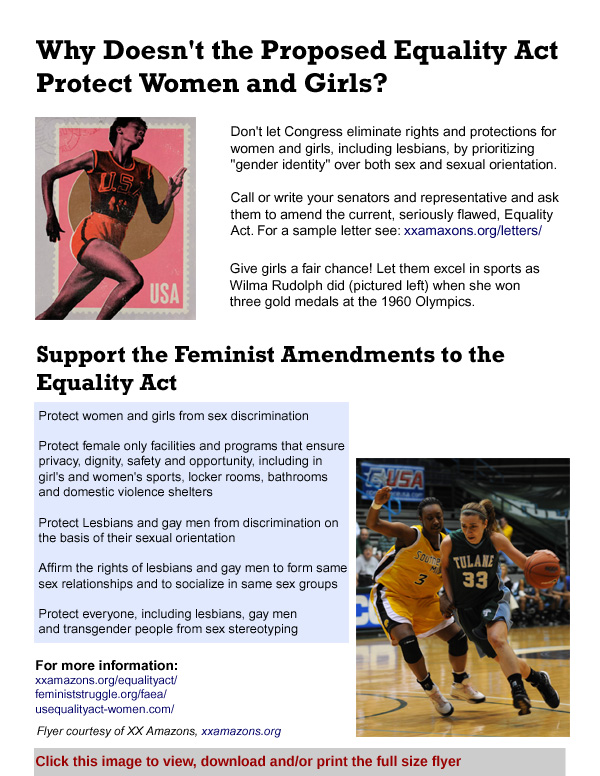
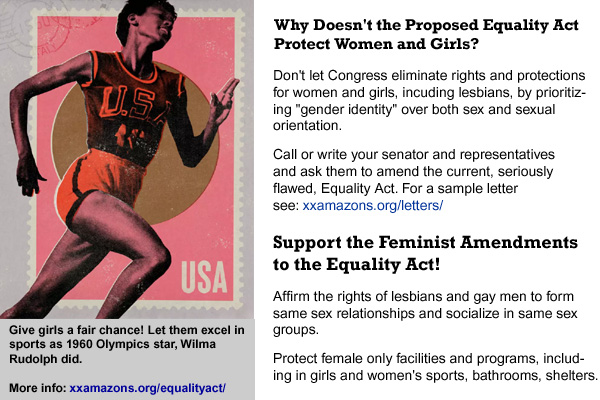
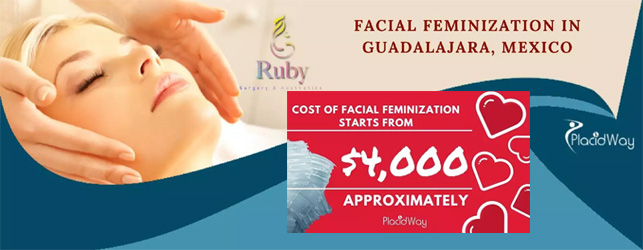

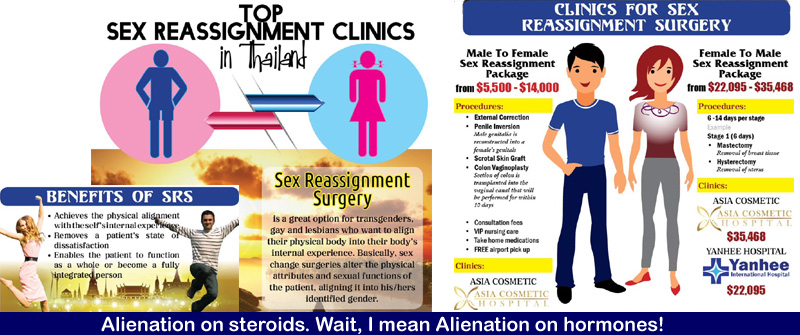




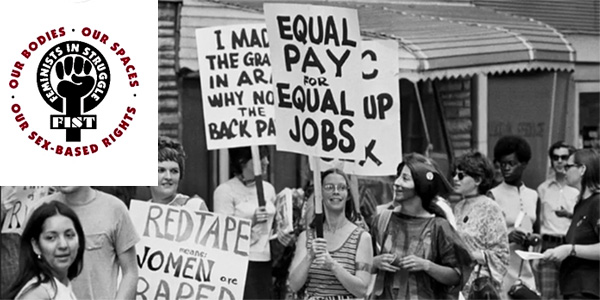


 Sheila Jeffreys traced the origins of the concept of “gender identity” in her book, Gender Hurts. In the 1950s and 1960s the medical profession became increasingly engaged with males who wanted to take advantage of advancing medical technologies in endrocrinology and surgery to become transsexual. At that time, the medical profession could not agree on what kinds of treatments were ethical. Some medical professionals strongly believed that treatment should be limited to psychological methods. The sexologists who offered physical treatment hit upon the use of the word “gender” to justify the harms they were inflicting on healthy bodies. Jeffreys quotes Bernice Hausman, who explained in her book, Changing Sex, Transsexuality, Technology and the Idea of Gender, that this justification required “construction of a rhetorical system that posits a prior gendered self.” (p. 27, Gender Hurts) Hausman described gender as “the idea of an identity prior to and within the body that theoretically should dictate the appearance of the subject.” (p. 27, Gender Hurts) (Note: the word “gender” was being used then, but today, “gender identity” would be used.)
Sheila Jeffreys traced the origins of the concept of “gender identity” in her book, Gender Hurts. In the 1950s and 1960s the medical profession became increasingly engaged with males who wanted to take advantage of advancing medical technologies in endrocrinology and surgery to become transsexual. At that time, the medical profession could not agree on what kinds of treatments were ethical. Some medical professionals strongly believed that treatment should be limited to psychological methods. The sexologists who offered physical treatment hit upon the use of the word “gender” to justify the harms they were inflicting on healthy bodies. Jeffreys quotes Bernice Hausman, who explained in her book, Changing Sex, Transsexuality, Technology and the Idea of Gender, that this justification required “construction of a rhetorical system that posits a prior gendered self.” (p. 27, Gender Hurts) Hausman described gender as “the idea of an identity prior to and within the body that theoretically should dictate the appearance of the subject.” (p. 27, Gender Hurts) (Note: the word “gender” was being used then, but today, “gender identity” would be used.) The “born that way” ideology still provides many medical practitioners and researchers with a meal ticket. The work of these professionals props up gender identity ideology. Consider
The “born that way” ideology still provides many medical practitioners and researchers with a meal ticket. The work of these professionals props up gender identity ideology. Consider 